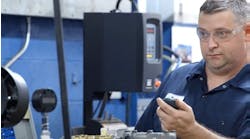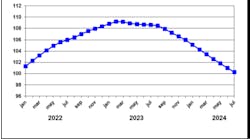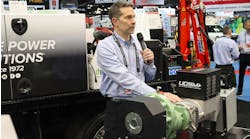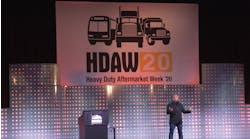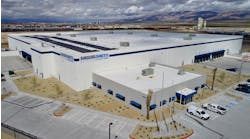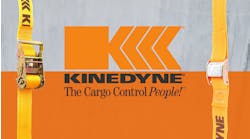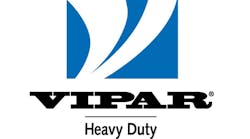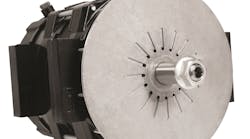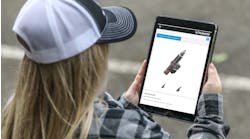Fontaine Trailer Company's PartSource is working just as it was drawn up by not trying to be all things to everyone
Fontaine Trailer Company had been in business for over 60 years and had become the largest flatbed trailer manufacturer in the world. But it had never really tried to focus on aftermarket parts, instead selling parts from each of its manufacturing plants with part-time personnel.
“It was really a fractured effort,” Ed Wentz says. “We had a bunch of heroes trying to do the right thing, but we didn't have the right resources or tools to do the job correctly. Dealers and fleet customers indicated a strong need for us to simplify the process and focus on parts.”
That's how Fontaine PartSource was birthed as the aftermarket parts unit of Fontaine Trailer.
Early in 2006, Fontaine hired David Lee as director of operations and put him in charge of gathering data and consolidating plans. Lee had 12 years' experience in aftermarket parts at Heil Environmental Industries, serving there as customer service manager along with management roles in operations and purchasing.
Then Fontaine hired Wentz as president of PartSource. Wentz brought 34 years' experience with companies in Marmon Highway Technologies, part of the Marmon Group that owns Fontaine. Wentz also had been president of the OEM Truck Business Unit of Webb Wheel Products Inc.
Since both Lee and Wentz had experience in Marmon, they were familiar with the company's philosophy of using the 80/20 principled business model. It's based on the Pareto Principle, which states that for many events, 80% of the effects come from 20% of the causes.
For the Marmon companies, that means that 20% of their customers generate 80% of the results. As a management group, they focus on the top 20% of their customers and the key products and services most important to them.
“We sliced and diced all the data relative to our customers buying parts to determine who our current key customers were and also did the same thing with the products they were buying,” Wentz says. “That allowed us to start planning what the facility should look like and what type of investment we needed to satisfactorily meet our key customers' needs.
“We knew from the beginning that we weren't going to try to copy the big PDC aftermarket houses that were out there at the time. Having been on the manufacturing side, I had done business with a lot of them. They're all good companies with good management teams, with a lot of the same products we sell. The only thing I don't envy them on is size and scope. They have far too much complexity built into their 100,000-square-foot warehouses and 50,000-plus SKUs.
“Our competition got there by trying to be all things to everyone. We had meetings with our key dealers to talk about processes and how to set the business up, and they realized there are things they need from time to time that they don't order often, but when they need them, they have time to wait for them. But over the years, the bigger distribution centers that are stocking 50,000 SKUs order things that sit on the shelves for years with dust sitting on them, and they're hoping somebody will need them.”
Facility in Jasper
In the end, Fontaine decided to go with a 15,000-square-foot facility that would have the capacity to stock 2000 SKUs.
By June 2006, Fontaine had completed the facility in Jasper, Alabama, at an industrial park that sits close to what will become Interstate 22, a corridor connector from Birmingham to Memphis, providing easy logistical access.
Two years later, Wentz and Lee say it has worked exactly as they had envisioned.
“We're a bit of a different player in the market compared to those that I believe the market would associate us with as a competitor,” Wentz says. “We stay focused on the customers in the areas of the market we know and then build on this. We'll test variations or enhancements to the existing products and services as long as they're important to our key customers. We don't try to be all things to everyone.
“It's a thought process that's really counterintuitive and counter to almost everything that company leaders have been taught their entire business careers. We have an opportunity to sell a lot of things and there are several ways to sell them, but we know that our success really is going to come if we remain focused on a few well-defined key customers and their needs. Our key customers have told us their primary need is for us to be easy to do business with. They have struggled with their aftermarket parts suppliers over the years, and even with us before we got focused on it, with the difficulty of doing business — looking up parts, identifying parts on a trailer, those sorts of things. It seems so simple, but it takes commitment and some nimbleness — the ability to move quickly when key customers' needs change.”
Wentz says that it's a simple mathematical process to ascertain the top 20% of Fontaine's customers and the top 20% of what they buy, since they are continually analyzing who their key customers are.
Rather than following inventory turns and following the movement on a particular SKU through a computer program, it's easy for them to pinpoint items that are selling the most.
“As result of that, we are pretty good at having everything our key customers move the most, having them readily available,” he says. “Depending on the key customer, it allows us to help them manage their inventory either by suggesting that they have these items in stock because this is the top 20% of what they buy, or it allows us to make sure we have it in stock so we can give them a quick turnaround when they order.”
Lee says they listen very closely to their customers, so the inventory is a direct reflection of what they are telling Fontaine.
“If we know they're using high-volume parts, we actually put them on the shelves so we can ship them the same day,” he says. “Everything else we ship directly from a supplier or we would work with a supplier to eliminate the lead time so it doesn't matter if it's sitting on our shelf or a supplier's shelf. If you think about 80/20, 80% of the time a customer is going to order those parts that are fast-moving on the shelf. The other 20%, we're going to do something with it. It's still going to take care of the customer, but do something different.”
Online parts catalog
Wentz says Fontaine has been able to reduce the business and transaction complexity, especially with its online parts catalog, Fontaine PartSource ESP (Easy Source Parts) at: http://www.fontainepartsource.com
With ESP, a customer can locate the needed part and place an order in seconds. The technology places a vast array of Fontaine Trailer component information right at a customer's fingertips. A search can be done by part number, description, serial number, or supplier category. After the part is found, it can be simply added to the shipping cart by indicating the quantity.
ESP gives Fontaine's distributors more freedom to take care of their customers while Fontaine takes care of their trailer parts needs.
“We looked at ways to make it easier for our customers to look up parts and order online. We didn't do what our primary competitors did and call them ‘Parts 1, 2, 3,’ ” he said. “Companies like that have great software and do a good job for their customers. One of the advantages they have is that most of the will-fit parts are already loaded into the system. They probably have a good history of movement of parts, so it makes it easier for a PDC or warehouse distributor to get started. They don't have to enter a lot of data or spend a lot of money in that part of the exercise.
“But we chose a different route because we not only wanted it to be easy to use, but we wanted to be integrated with our business system without spending hundreds of thousands of dollars in purchasing out-of-the-box software or computer systems we didn't think we would get full utilization out of. We found a local software developer that could build us a system that was very Internet-friendly and would also integrate with our business software, which we already had purchased and was software used throughout the organization.
“It allows us to let our customers into our business systems to order products, to look up part numbers, identify them, place an order. They can actually see if the product is on hand or, if it is a special-order product, they can place an order. In some cases, we've developed a system with suppliers on an item that is non-stocking item: Once the order is placed by a customer, our order goes directly to our supplier, so we don't have that transaction of somebody taking the order here at Fontaine, processing it, putting an order requisition in to the purchasing manager, and then having to order the product for a direct-ship item. So we have a seamless transaction. The customer knows in most cases, it's going to be a direct-ship item but he doesn't lose a day or a day and a half by someone processing that order all the way through the value chain.”
Lee says the idea is to simplify a complex system so the customer doesn't have to have a tremendous working knowledge of a product. For example, Fontaine has taken industry part numbers and cross-referenced them back so that in one click, a customer can seamlessly move throughout PartSource's system.
“We like to term it, ‘marrying the languages,’ ” he says. “Everybody in the industry uses a different language. We like to tear those barriers down and truly simplify the whole process for our customers. We don't want the customer to have a tremendous amount of clicks. We want them to be interactive and in a short amount of time get to the product they're looking for. In that, we found we can become more efficient and not have a large staff and truly empower the customer to do lot of things they haven't been able to do before.”
Listening to customers
Wentz says another thing that separates PartSource from its competition is willingness to listen to customers. That's how PartSource developed a program in which it offers for-sale options on heavy-haul trailers.
“Our dealers need quick availability on heavy-haul options, such as a flip axle on the back of a removable gooseneck trailer,” he says. “Typically, they won't order that with a trailer for stock. They just order the trailer because they don't know if and when a customer will come in that wants a trailer and a flip axle. In the past, if a customer came in and wanted to buy a trailer on the yard and needed a flip axle, the dealer typically wouldn't have a flip axle. So he would wait and order that flip axle through our dealer group and would have to wait for a normal production run for that flip axle to be built, which creates an obvious delay in delivering the bigger part of the prize — the trailer.
“So in listening to customers, we developed a program in conjunction with dealer business and manufacturing facilities for us to analyze the market and understand what the market demand was for flip axles and spreaders and deck inserts to lengthen heavy-haul trailers, and we developed our own line of inventory. We had it built and put in place ready for immediate delivery. It's been a remarkably successful business for us and improved our dealers' ability to customize trailers that they sell without creating complexity on our manufacturing line.
“Now David is investigating opportunities for other options for heavy-haul trailers. There are so many different things that contractors and truckers move on specialized trailers. Almost every hauling application is different. No trailer manufacturer can be really effective in offering everything to everybody coming down the assembly line. We're able, as another business unit of Fontaine Trailer, to step in there and treat those lower volume things and give the customer better service.”
Fontaine has a PartSource Partner Program that includes 21 Fontaine PartSource dealers covering 33 market areas in the US and Canada. PartSource Partner dealers enjoy the best-value options and service levels available from Fontaine PartSource in return for merchandising, promotion, volume, and stocking commitments.
“We developed a program to reward our dealers that are committed to growing their business with us,” Wentz says. “We have many good dealers around the US and Canada that have stepped up with their willingness to serve Fontaine Trailer customers with enhanced product knowledge, on-hand inventory, and superior service. For that, our partners enjoy financial and service level benefits not available to non-partner dealers.”
Wentz says that aside from internal Fontaine suppliers that supply proprietary parts, PartSource does strong business with Hendrickson on suspensions, Grote and Phillips on lighting products, and Ancra on load-control products.
He says Fontaine has worked hard to win its share of the hydraulic-cylinder business, which has been brought on by heavy-haul products in North America that use a lot of hydraulics in removal gooseneck applications. Hyco is a Fontaine partner.
In hardwood, Fontaine has partnered with Overseas Hardwood and is looking for ways to develop kits that are easier to handle than one board or a whole 40' length of hardwood.
PartSource fits nicely into Fontaine Trailer's organization of distinct, autonomous business units, which also includes the Dealer Business Unit, Fleet Business Unit, and Military Products Group.
The Dealer Business Unit, headquartered 35 miles northwest of Jasper in Haleyville, Alabama, provides sales, service, and support to the nationwide network of Fontaine Trailer dealers. Trailers are manufactured for the Dealer Business Unit at Fontaine factories: aluminum platform trailers at a facility in Kent, Ohio; lowbed trailers in Springville, Alabama, 49 miles south of Haleyville; and steel and composite platform trailers at the flagship facility in Haleyville.
The Fleet Business Unit is headquartered in Jasper, adjacent to PartSource, and concentrates on serving the nation's larger independent fleets. At the Jasper trailer plant, Fontaine manufactures steel and aluminum combination trailers for large fleet customers throughout North America. In addition, the Fleet Business Unit is supplied with aluminum trailers from the Kent plant and lowbed trailers from the Springville plant.
The Military Products Group manufactures heavy-haul trailers for the Department of Defense. Headquartered in Princeton, Kentucky, this unit works closely with United States Armed Forces to design and build trailers that withstand the punishing conditions associated with military applications.
